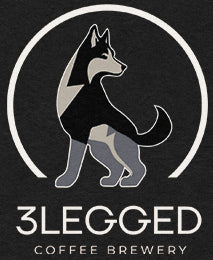Recently Yami, our founder of Three Legged Brewing was inteviewed by Coldbrewpak on all things packaging related to cold brew. Read the full article here.
Before taking the world by storm in recent years, cold brew as a coffee category was largely unknown. According to a recent report by the National Coffee Association, the popularity of cold brew coffee has increased by 300% by 2016. The shift, predominantly led by the younger demographic drawn to the blend of convenience and smooth, non-acidic flavours, shows no signs of slowing.
The demand has created a need for innovation among brands, which has brought a range of flavoured cold brew coffee options to the market. Flavoured variations allow brands to showcase creativity and breathe new life into the cold brew experience.
3Legged Coffee Brewery, based in Illinois, is at the helm of the shift. The brand offers flavoured cold brew coffees that “taste just like treats without any junk.” But how has the brand managed to preserve the flavoured components of its cold brew coffees until it reaches consumers?
I spoke with Yami Hu, the founder of 3Legged Coffee Brewery, to learn more about packaging flavoured cold brew coffee.
Factors to consider when packaging flavoured cold brew
Packaging cold brew coffee involves navigating several important factors, each of which plays a significant role in preserving the beverage’s unique flavours.
Yami is also the head brewer at 3Legged Coffee and provides insight into how the beverage should be packaged. She underscores the importance of considering elements such as flavour degradation, product safety, packaging integrity, and shifts in consumer preference.
“From a consumer perspective, we prioritise convenience, portability, aesthetics, and sustainability when packaging flavoured cold brew coffee,” she explains. “Additionally, it should be designed for easy consumption, allowing for quick ‘chugging’ due to its smaller serving size and high caffeine content.
“Convenience is paramount, as consumers often grab and go. Therefore, the can should be portable for easy transport, and fit conveniently in a car without requiring a cap. It should also be compact enough for storage in a home fridge or transport while on the go,” she adds. Notably, as of 2024, Millennials are leading the market demand for ready-to-drink (RTD) beverages. Furthermore, their younger counterparts, Gen Z, are not far behind.
“Aesthetics play a crucial role as well,” Yumi adds. “[Younger] consumers are drawn to visually appealing cans, and some may even make purchasing decisions based on the artwork alone. Finally, sustainability is key, with aluminium cans being recyclable and widely recognised as such by consumers.”
Yami notes that a major concern when packaging cold brew coffee is flavour degradation. The infusion of flavours into the coffee introduces a delicate balance that can be easily disrupted by external factors such as exposure to light, air, or temperature fluctuations during packaging and storage. Over time, these elements can lead to a deterioration in taste quality, ultimately diminishing consumer satisfaction and brand reputation.
Product safety is the priority when offering cold brew coffee. Packaging with the appropriate barrier protection can help prevent contamination, microbial growth, and other major health risks. Yumi also notes that packaging integrity is another critical consideration. Poorly sealed or damaged packaging poses a major risk of spoilage or contamination.
Which packaging is best for flavoured cold brew coffee?
Naturally, there are risks when it comes to packaging a product such as cold brew coffee. Yumi explains why 3Legged Coffee made the decision to switch to cold brew coffee cans.
“From a manufacturer’s perspective, we prioritise shelf life, cost, availability, and packaging design,” she says. “Cans are the preferred choice, as they’re readily available from canning providers or co-packers that are catering to emerging brands. They also stack well for storage and transportation.
“As a small-batch coffee brewery, we’re incredibly passionate about [the art on cans],” she adds. “Drawing parallels to the craft beer industry, we believe that design plays a pivotal role. With just a split second to capture consumers’ attention in a grocery store aisle, cans offer a superior medium to convey our artisanal image and share our brand story.”
Cold brew coffee cans have allowed the brand to express its unique voice and personality by allowing it to feature captivating designs that convey the brand’s story. Packaging design plays a pivotal role in shaping consumer perception and boosting loyalty. It often transcends the basic function as a protective shield for products, serving as a cornerstone of consumer perception and brand identity.
While cold brew coffee cans are 3Legged’s preferred packaging choice, other brands may search for alternatives for their products. BPA-free, recyclable plastic bottles and flexible pouches also serve as attractive RTD offerings that allow for full customisation.
What to consider when offering flavoured cold brew?
Yumi shares invaluable insights for cold brew brands into the considerations that should inform packaging decisions:
Consumer Perception: “Cans and bottles are the go-to choices for RTD coffee and appeal to a wide consumer base,” she says. “However, brands incorporating functional ingredients, such as protein, may opt for unique packaging that is commonly associated with protein drinks.”
Serving Size: “Determine whether your product is single-serve or multi-serve. For larger quantities, such as party-sized portions, jugs or totes are often used,” she explains.
Caffeine Content: Yumi advises brands to consider the caffeine concentration of their product. “Highly potent or concentrated coffee may be stored in amber glass bottles to distinguish them as not ready-to-drink beverages.”
End Users: “Identify your target audience—consumers or cafes. For cafes, cost-effective packaging solutions like brew-in-a-bag (BIB) are favoured for larger volumes. PET kegs are popular for cafes seeking nitro cold brew on tap.”
Manufacturing capability: “If you use a co-packer, it’s essential to choose packaging that aligns with the co-packer’s capabilities to ensure product safety and quality. If you manufacture in-house, the capital requirement for the facility is a big factor,” she explains.
Pasteurisation Method: “If you make a shelf-stable product, the pasteurisation methods and the availability at the co-packer also influence the decision,” Yumi concludes.
At Cold Brew Pak, we understand the importance of catering to convenience. This is why we offer bespoke, ready-to-grab aluminium cans. Cans for cold brew coffee are a highly popular option because they are convenient, sustainable, and aesthetic.
Our 100% recyclable aluminium cold brew coffee cans are designed to accommodate a variety of cold beverages and diverse drinking occasions. Lightweight and robust, they offer superior protection against light and oxygen and are infinitely recyclable.
Pair your recyclable cold brew coffee cans with our custom printed can carriers: a sustainable and convenient solution for transporting your cold brew coffee beverages. Available in 4- and 6-packs.
Images courtesy of 3Legged Coffee Brewery


